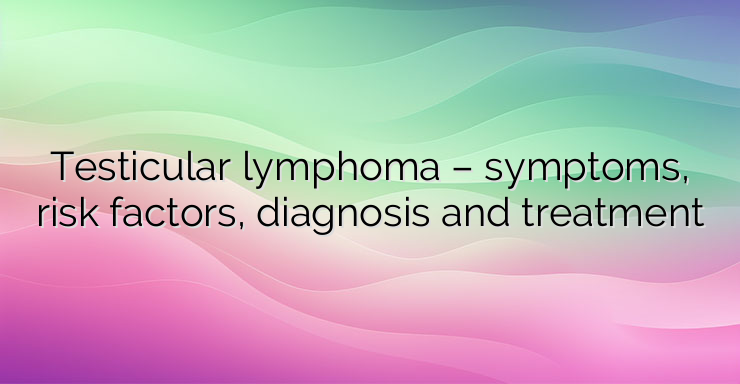What is testicular lymphoma? Tumors originating from germ cells are the most common form of testicular cancer, while less than 5% of men with testicular cancer have lymphoma. However, testicular lymphoma is the most common type of testicular cancer in men over the age of 60. Testicular lymphoma is usually a type of non-Hodgkin’s lymphoma, a type of cancer that occurs in the lymphatic system, which is part of the immune system and consists of a network of vessels and glands that extend throughout the body. Non-Hodgkin lymphoma affects lymphocytes, the white blood cells that fight pathogens in the clear fluid (lymph) that flows through lymph vessels. Non-Hodgkin’s lymphoma causes lymphocytes to multiply and accumulate abnormally in the lymphatic system, such as in the lymph nodes. This causes lymphocytes to lose their ability to fight infections, leaving the body vulnerable to them. The most common type of testicular lymphoma is diffuse large B-cell lymphoma, which affects white blood cells called B lymphocytes. Testicular lymphoma usually presents as a swelling or mass in the testicles. What are the causes of testicular lymphoma? Specialists do not know the exact reasons for the appearance of lymphoma of the testicles, but some viral infections are associated with the development of the disease. These include: HIV; Epstein-Barr virus; Parvovirus B19, which causes erythema infectiosum or fifth disease; Human cytomegalovirus What are the symptoms of testicular lymphoma? The most common symptom of testicular lymphoma is an enlarged testicle. The swelling does not cause pain, but in some cases affected men may experience sharp pain along with the swelling and the testicles may feel heavier than usual. Depending on whether the lymphoma has spread, a man may also experience other symptoms related to the affected areas. The person may also experience systemic symptoms, such as night sweats, weight loss, and fever. What are the risk factors for testicular lymphoma? Risk factors for developing testicular lymphoma include: Advanced age. Men over the age of 60 are at greater risk of developing this type of cancer than younger men; Infection with certain other viruses, such as Epstein-Barr virus, HIV, parvovirus B19 and cytomegalovirus; Exposure to cancer-causing chemicals and radiation Lymphoma may first develop in the testicles and is then called primary testicular lymphoma. Also, the lymphoma may first develop in another organ and spread or metastasize to the testicles and other parts of the body, in which case it is called secondary testicular lymphoma. How is testicular lymphoma diagnosed? There are many possible reasons why a testicle may be swollen or enlarged, and this does not necessarily mean that a man has testicular cancer. The doctor can identify other conditions or rule them out, but if a tumor is suspected,an ultrasound examination of the testicles may be performed. Blood tests to check for tumor markers may also be ordered. Specialists usually avoid a biopsy, which can increase the risk of the cancer spreading. Instead, if a tumor is found, surgery may be performed to remove the testicle to identify the type of tumor. Once the tissue is analyzed, a diagnosis can be made. The doctor will also determine the stage of the cancer based on the size and location of the tumor and whether it has spread to other organs. In this case, a CT scan of the chest, abdomen and pelvis may be ordered, but the testicles will be protected during the examination. It is necessary to take into account the stage and type of lymphoma when developing a treatment plan and determining the prognosis of the disease. What is the treatment for testicular lymphoma? Testicular cancer is usually treated by surgically removing the tumor and using techniques to prevent the cancer from recurring in the other testicle and elsewhere in the body. These treatments may include: Surgical treatment – orchiectomy (surgery to remove the testicle) of the affected testicle. This is also part of the diagnosis of the type of cancer; Chemotherapy. Chemotherapy called R-CHOP (Combination Drug Name) is usually administered, including targeted therapy consisting of rituximab along with cyclophosphamide, hydroxydaunorubicin, vincristine, and prednisolone; Radiotherapy. Radiotherapy may be given to the pelvic area, which may help reduce the risk of cancer coming back (recurring) in the other testicle; Prophylaxis of the central nervous system. This involves injecting a chemotherapy drug directly into the space between the thin layers of tissue (meninges) that cover the spinal cord and brain. Alternatively, high doses of chemotherapy are injected intravenously to kill cancer cells in the central nervous system; Immunotherapy. Chimeric antigen receptor (CAR) T cell therapy is a therapy that modifies the body’s T cells to help fight and destroy cancer cells in the body. Approved CAR T-cell therapies for testicular lymphoma include Kymriah (tisagenlecleucel) and Yescarta (axicabtagene ciloleucel) What is the prognosis for testicular lymphoma? Testicular lymphoma is an aggressive cancer and has a higher 5-year survival rate if diagnosed at an early stage and the patient receives appropriate treatment. The prognosis depends on some factors, such as: The size of the tumor; Stage of cancer at diagnosis; Age of the patient; The presence of other symptoms; The spread of cancer to other places; In which testicle the lymphoma developed – lymphoma in the left testicle can worsen the prognosis. References: 1. National Cancer Institute (NCI). Cancer Stat Facts: Testicular Cancer 2. National Health Service (NHS). Overview:Non-Hodgkin lymphoma 3. American Cancer Society. What Is Non-Hodgkin Lymphoma? 4. Medical News Today. What to know about testicular lymphoma


Leave a Reply